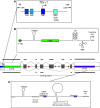Regulation of eukaryotic gene expression by the untranslated gene regions and other non-coding elements
- PMID: 22538991
- PMCID: PMC3474909
- DOI: 10.1007/s00018-012-0990-9
Regulation of eukaryotic gene expression by the untranslated gene regions and other non-coding elements
Abstract
There is now compelling evidence that the complexity of higher organisms correlates with the relative amount of non-coding RNA rather than the number of protein-coding genes. Previously dismissed as "junk DNA", it is the non-coding regions of the genome that are responsible for regulation, facilitating complex temporal and spatial gene expression through the combinatorial effect of numerous mechanisms and interactions working together to fine-tune gene expression. The major regions involved in regulation of a particular gene are the 5' and 3' untranslated regions and introns. In addition, pervasive transcription of complex genomes produces a variety of non-coding transcripts that interact with these regions and contribute to regulation. This review discusses recent insights into the regulatory roles of the untranslated gene regions and non-coding RNAs in the control of complex gene expression, as well as the implications of this in terms of organism complexity and evolution.
Figures

References
-
- Amaral PP, Dinger ME, Mercer TR, Mattick JS. The eukaryotic genome as an RNA machine. Science. 2008;319:1787–1789. - PubMed
-
- Andreassi C, Riccio A. To localize or not to localize: mRNA fate is in 3′UTR ends. Trends Cell Biol. 2009;19:465–474. - PubMed
-
- Arce L, Yokoyama NN, Waterman ML. Diversity of LEF/TCF action in development and disease. Oncogene. 2006;25:7492–7504. - PubMed
Publication types
MeSH terms
Substances
LinkOut - more resources
Full Text Sources
Other Literature Sources

